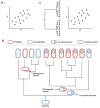A phylogenetic approach to comparative genomics
- PMID: 39779997
- PMCID: PMC7617348
- DOI: 10.1038/s41576-024-00803-0
A phylogenetic approach to comparative genomics
Abstract
Comparative genomics, whereby the genomes of different species are compared, has the potential to address broad and fundamental questions at the intersection of genetics and evolution. However, species, genomes and genes cannot be considered as independent data points within statistical tests. Closely related species tend to be similar because they share genes by common descent, which must be accounted for in analyses. This problem of non-independence may be exacerbated when examining genomes or genes but can be addressed by applying phylogeny-based methods to comparative genomic analyses. Here, we review how controlling for phylogeny can change the conclusions of comparative genomics studies. We address common questions on how to apply these methods and illustrate how they can be used to test causal hypotheses. The combination of rapidly expanding genomic datasets and phylogenetic comparative methods is set to revolutionize the biological insights possible from comparative genomic studies.
© 2025. Springer Nature Limited.
Conflict of interest statement
Competing interests: The authors declare no competing interests.
Figures




References
-
- Binnewies TT, et al. Ten years of bacterial genome sequencing: comparative-genomics-based discoveries. Funct Integr Genomics. 2006;6:165–185. - PubMed
-
- Hunt M, Lima L, Shen W, Lees J, Iqbal Z. AllTheBacteria - all bacterial genomes assembled, available and searchable. 2024:2024.03.08.584059. doi: 10.1101/2024.03.08.584059. Preprint. - DOI
Publication types
MeSH terms
Grants and funding
LinkOut - more resources
Full Text Sources

